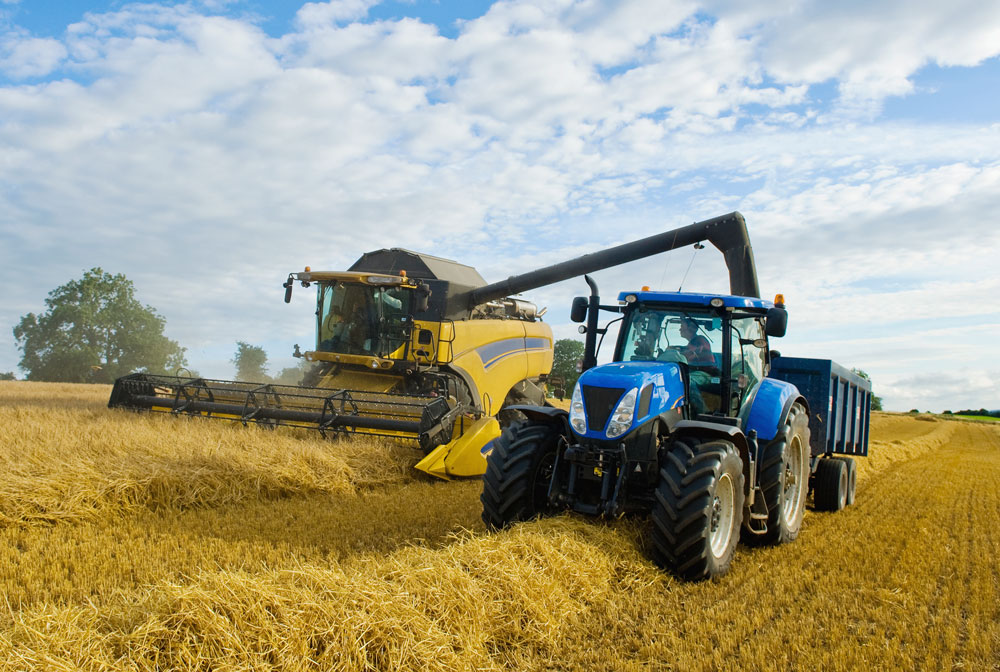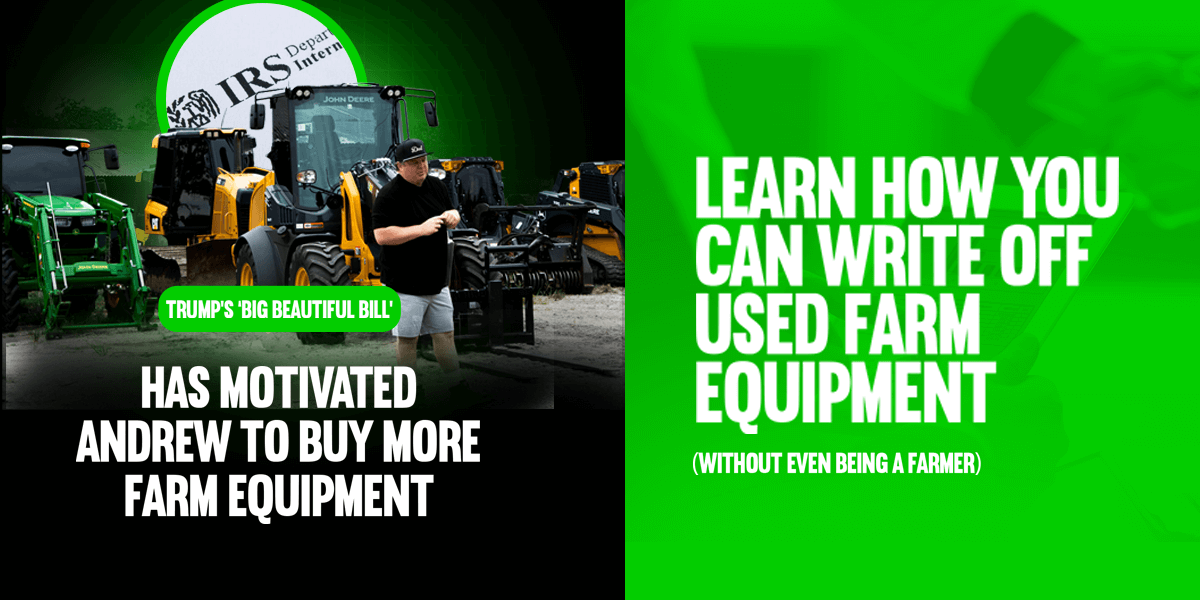The IRS doesn’t care if you’ve never touched a tractor. They care if you own one.
Most entrepreneurs think equipment depreciation is for farmers and construction companies. Meanwhile, strategic owners are buying used tractors for $250,000 and writing off the entire purchase in year one—regardless of whether they’ve ever set foot on a farm.
The Big Beautiful Tax Bill didn’t just help agriculture. It weaponized equipment ownership for anyone smart enough to understand how the tax code really works.
The Equipment Write-Off Revolution
Before the recent tax changes, the IRS treated used equipment like a second-class citizen. You could get bonus depreciation on new machinery, but used equipment had to suffer through traditional depreciation schedules. The Big Beautiful Tax Bill changed that game forever.
Now, used farm equipment qualifies for 100% bonus depreciation. Translation: You can write off the entire purchase price in the first year, whether you bought it new from the dealer or used from another farmer.
This isn’t a loophole. It’s a feature designed to encourage investment in productive assets.
The $250K Tractor Strategy
Here’s how the math works for a high-income entrepreneur:
You purchase a used combine harvester for $250,000. Under the new rules, you can:
- Deduct the full $250,000 in year one through bonus depreciation
- Reduce your taxable income by $250,000
- Save approximately $60,000-$90,000 in federal taxes (depending on your bracket)

The equipment doesn’t disappear. You still own a $250,000 asset. You just erased a quarter-million dollars from your tax bill while acquiring something that can generate income through leasing or farming operations.
Section 179 Gets Supercharged
The Section 179 expensing limit jumped to $1 million with a $2.5 million phaseout threshold. This means you can immediately expense up to $1 million in qualified equipment purchases, and the benefit doesn’t start phasing out until you’ve purchased $2.5 million worth of equipment in a single year.
For perspective: You could buy multiple pieces of used farm equipment—tractors, harvesters, irrigation systems—totaling $1 million and write off every dollar immediately.
The beauty of Section 179 is its flexibility:
- No requirement to use the equipment personally
- Applies to both new and used equipment
- Can be combined with other depreciation strategies
- Works for any business that uses the equipment in trade or business
Faster Depreciation Schedules
The tax bill also shortened recovery periods for farm machinery from seven years to five years. This might seem like a small change, but it fundamentally alters the wealth-building equation.
Faster depreciation means:
- Larger deductions in earlier years
- More cash flow to reinvest
- Accelerated wealth accumulation through tax savings
Think of depreciation as government-subsidized wealth building. The faster you can depreciate an asset, the quicker you get your tax benefits, and the sooner you can deploy that saved capital into new investments.
The Interest Deduction Advantage
Farm businesses can opt out of the Section 163(j) interest limitation rules, which normally cap business interest deductions at 30% of adjusted taxable income. For equipment-heavy operations requiring significant financing, this exemption can save tens of thousands in taxes annually.
The tradeoff? Opting out requires using the Alternative Depreciation System (ADS), which provides slower depreciation. But strategic planners use this choice selectively—opting out for highly leveraged equipment purchases where the interest savings exceed the depreciation benefits.
This Isn’t Just for Farmers
The most sophisticated entrepreneurs understand that these benefits aren’t limited to people who wear overalls and wake up at dawn. The tax code doesn’t care about your agricultural experience—it cares about asset ownership and business purpose.
You can access these benefits by:
- Equipment Leasing Operations: Purchase farm equipment and lease it to agricultural operations. You get the depreciation benefits while generating rental income.
- Agricultural Investment Funds: Structure ownership through entities that acquire and lease equipment to farmers. Multiple pieces of equipment across different entities can multiply your write-offs.
- Land and Operations: Combine equipment purchases with farmland acquisition. The equipment serves the farming operation, qualifying for agricultural tax benefits while the land appreciates.
- Ag-Adjacent Businesses: Food processing, agricultural technology, and farming support services often qualify for these same equipment depreciation benefits.
The Ownership Structure Game
Smart entrepreneurs don’t just buy equipment personally. They create structures that maximize tax benefits:
A leasing company owns the equipment and rents it to an operating company. The leasing company gets depreciation benefits while the operating company deducts lease payments. Both entities can be owned by the same person through different structures.
This separation allows for:
- Maximized depreciation on the equipment side
- Full deductibility of lease payments on the operating side
- Potential estate planning benefits through different ownership structures
- Liability protection between operations and assets
The Cash Flow Multiplier Effect
The real power isn’t just the tax savings—it’s what you do with the cash flow those savings create.
Take our $250,000 tractor example. The immediate tax savings of $60,000-$90,000 can be reinvested into:
- Additional equipment purchases (creating more depreciation)
- Business expansion (generating more income)
- Real estate investments (building long-term wealth)
- Other tax-advantaged investments
The equipment purchase becomes the catalyst for a larger wealth-building strategy, not just a single tax benefit.
Beyond Year One Benefits
While bonus depreciation provides immediate gratification, the long-term benefits compound. Equipment that generates rental income or supports farming operations creates ongoing cash flow while providing tax benefits in year one.
Quality used farm equipment often maintains value well, especially in today’s agricultural market. You’re not just getting tax benefits—you’re acquiring assets that can appreciate while providing immediate write-offs.
The Wealth Code Hidden in Plain Sight
The Big Beautiful Tax Bill’s equipment provisions reveal something fundamental about how wealth really works in America. The tax code isn’t designed to punish success—it’s designed to reward productive asset ownership.
While most entrepreneurs focus on income optimization, the wealthy focus on asset acquisition and strategic depreciation. They understand that ownership, not earnings, is the path to lasting wealth.
Equipment depreciation isn’t a farmer perk. It’s part of a broader system that rewards people who own productive assets, create jobs, and invest in real property.
The question isn’t whether these strategies work—it’s whether you’ll learn to think like an owner instead of an operator.
The IRS wrote the rules. The wealthy learned to read them. Everything else is just expensive ignorance.






